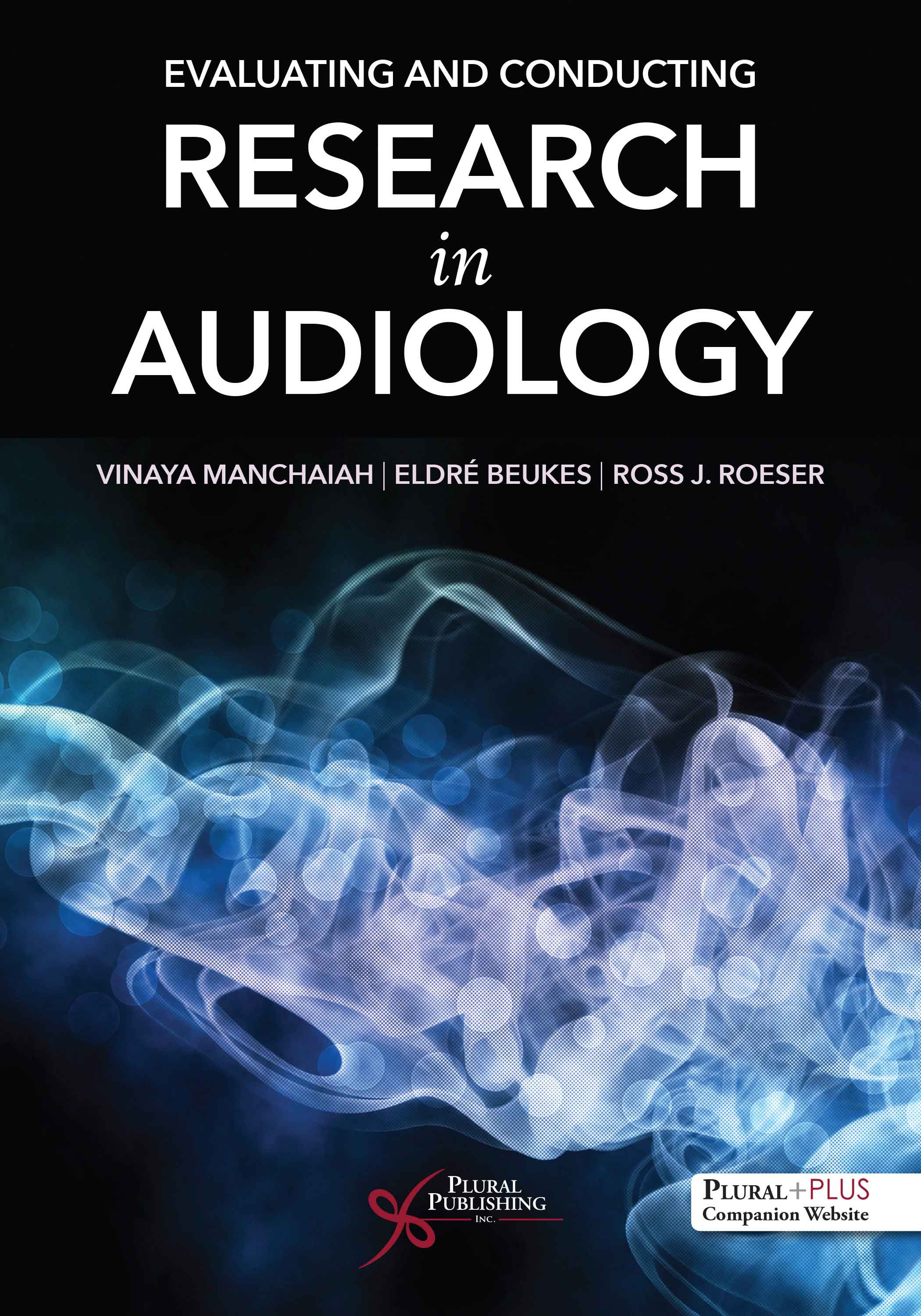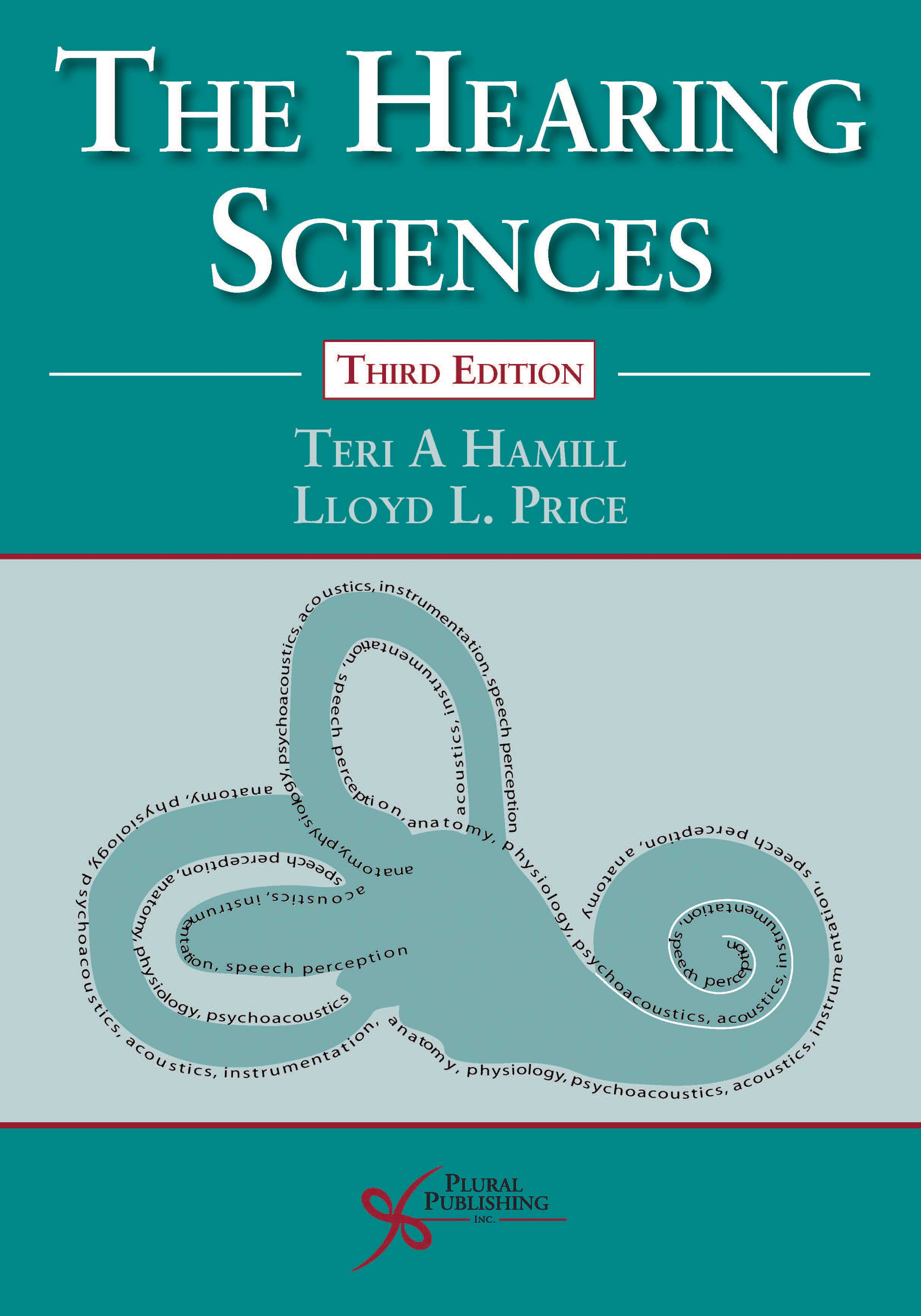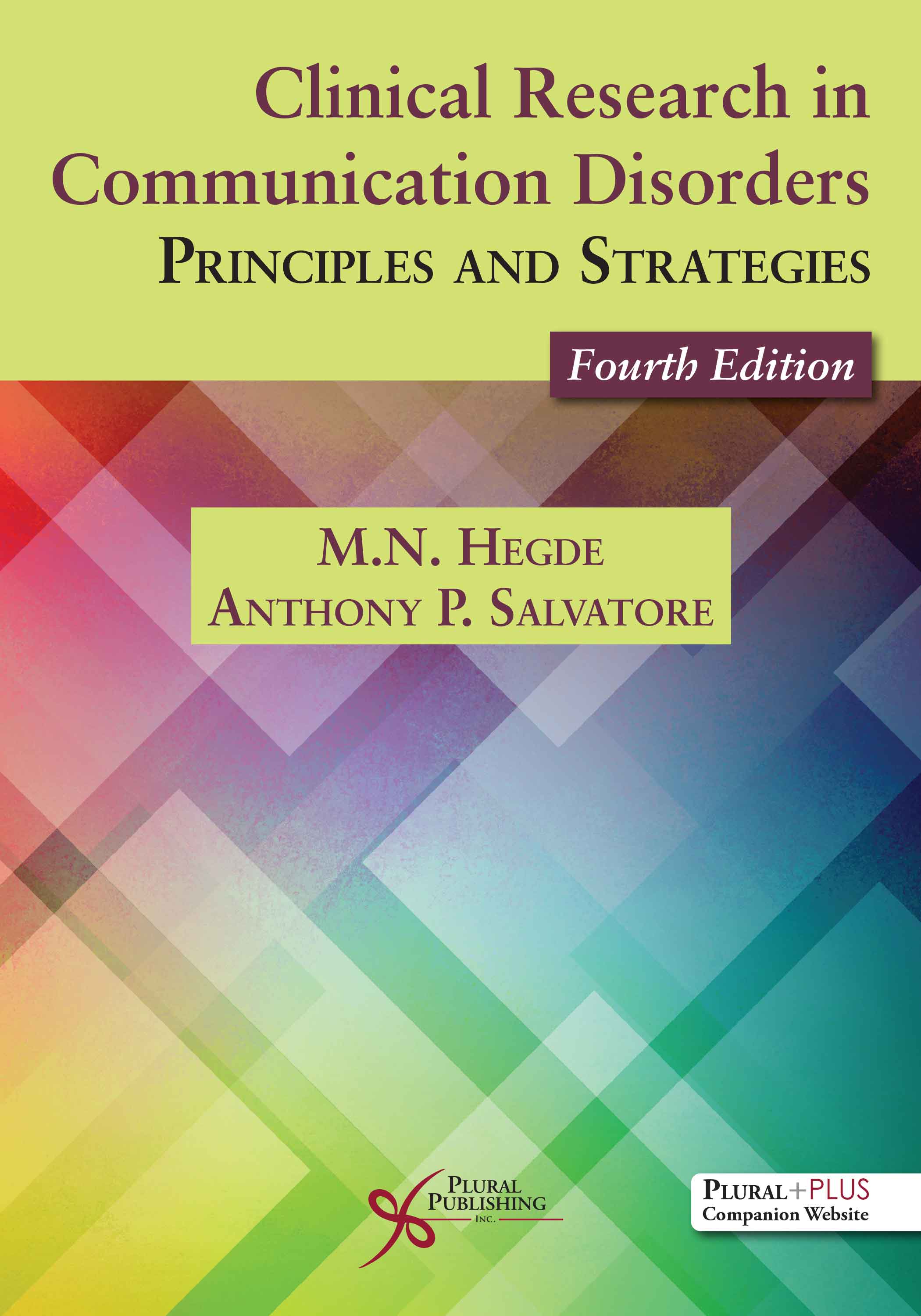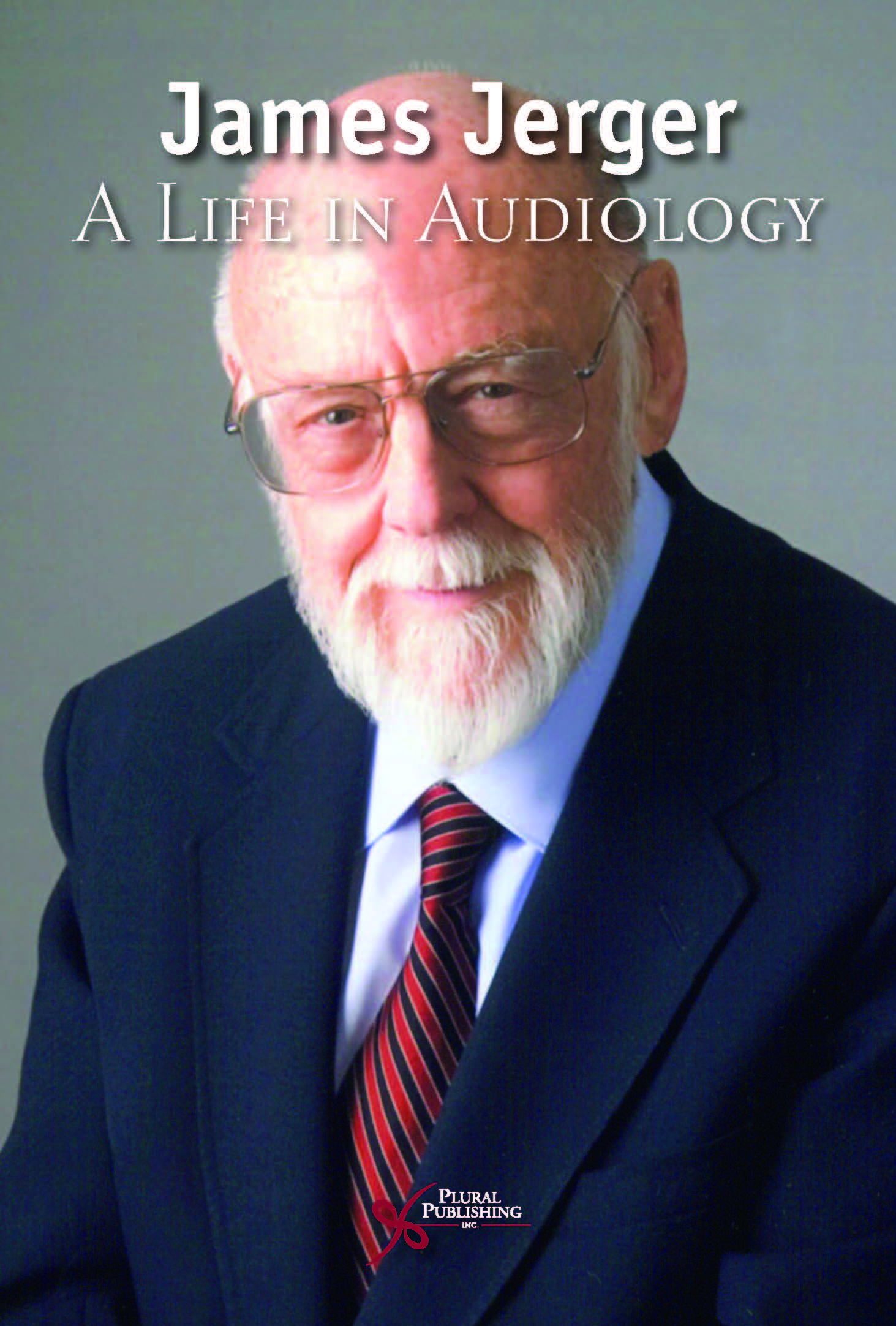
Evaluating and Conducting Research in Audiology
First Edition
Vinaya Manchaiah, Eldré W. Beukes, Ross J. Roeser
Details: 400 pages, B&W, Softcover, 7" x 10"
ISBN13: 978-1-63550-190-2
© 2022 | Available
For Instructors
Purchase
Evaluating and Conducting Research in Audiology is the first research methods textbook that is specific to the field of audiology and designed to serve as an academic textbook for audiology graduate students. This text can also be accessible for audiology practitioners who are interested in clinical and applied research. The comprehensive coverage includes materials for multiple courses within audiology degree programs, including research methods, analysis of professional literature, evidence-based practice, and capstone research projects.
Classroom tested, and written by authors who have extensive backgrounds in publishing and editing, this text provides knowledge that is required in evaluating, conducting, and disseminating research. The book is separated into three sections: (a) research methods; (b) evidence-based practice; and (c) conducting and disseminating research. Together, these sections provide a detailed coverage of the research methods that are relevant to conducting research, particularly in the field of Audiology.
Key Features
- Learning outcomes at the beginning of each chapter
- End of chapter reviews including key points and study questions
- Audiology-specific examples, research methods, and study designs
- “Golden Nugget” boxes throughout the book containing valuable information related to the critical concepts
- In-depth discussion of qualitative research methods, survey research methods, and systematic reviews to motivate students and early career researchers to consider these methodologies in their research
- Access to a PluralPlus companion website with PowerPoint lecture slides for instructors and study questions and related readings for students
From the Forewords:
"...What a pleasure to support these internationally acclaimed authors (each of whom is a researcher, clinician, and educator) in sharing their wealth of knowledge about how to close the gap between clinical research and clinical practice. ...If audiology is to thrive and grow into the future as a successful member of the health care professions, its clinical practices must develop a more research-based proof of efficacy. We need the kind of systematic, quantitative approach to pressing clinical issues so effectively detailed in this important volume."
—Susan Jerger, PhD
Ashbel Smith Professor Emerita School of Behavioral and Brain Sciences University of Texas at Dallas
—James Jerger, PhD
Distinguished Scholar-in-Residence School of Behavioral and Brain Sciences University of Texas at Dallas
"Evaluating and Conducting Research in Audiology is authored by Vinjaya Manchaiah, Eldré Beukes, and Ross J. Roeser, who are all clinicians, educators, and researchers. This text is an attempt to address the lack of evidence within our discipline, encourage critical evaluation of published studies, and develop good research practice. The authors are an established team, having collaborated on many research projects.
The chapters guide the reader through all the steps of the research process: critical synthesis of existing literature, identifying gaps-in knowledge that are clinically relevant, formulating a carefully crafted research question, identifying both the ingredients and the recipe to follow in order to answer the question, followed by data collection, analysis, and interpretation. ...There are ample opportunities for students and hearing health professionals to benefit from this textbook. The chapters on systematic reviews and evidence-based practice are directly relevant to the approach taken by various organizations (e.g., The Campbell Collaboration, Cochrane, NICE, Johanna Briggs Institute) that promote evidence-based practice. If you want to critically evaluate research, there are chapters for you. If you want to conduct research that uses quantitative, qualitative, mixed methods or surveys, there are also chapters for you. Health care professionals, new and experienced, are well placed to propose research questions based on an urgent unmet need, collaborate on a research study, apply for a short research “taster” session, work as a research audiologist, or undertake research training with the aim of becoming an independent researcher. A research-active workforce will enhance the reputation of the profession, as well as improve the lives of people with hearing loss."
—Kevin J. Munro, PhD
Ewing Professor of Audiology, Director of the Manchester Centre for Audiology and Deafness, Deputy Director of the NIHR Manchester Biomedical Research Centre
The University of Manchester, UK
"I was looking for text that would cover the fundamentals of the research enterprise for audiology graduate students, with a goal of enabling these students to become intelligent consumers of clinical research and, as desired, potential "doers" of clinical research. The latter role was important to this course because the completion of a student-led research project immediately follows this course in the curriculum. There were a couple of textbooks that met my criteria and could have been used, but the focus on audiological topics and examples tipped the scales in favor of this text for use in my course."
—Larry Humes, PhD
Emeritus Distinguished Professor
Speech, Language and Hearing Sciences
Indiana University
Reviews
"The book, Evaluating and Conducting Research in Audiology, by Manchaiah, Beukes, and Roesner provides a refreshing and timeless overview of research in audiology. It delivers a review for a clinical audiologist in the methods used to conduct research, how one should effectively read and synthesize research, as well as methods for applying the research to daily clinical practice. The authors hold true to clinical practices and application of research to answer every-day clinical questions. This is a book that will be recommended for all of our AuD students for applying research to practice throughout their career. This text provides a comprehensive overview of research methods and methods of examination for didactic courses as well as applications into clinic. The book also provides insight for researchers into clinical practice. There is something for the seasoned researcher and the newly engaged researcher. It provides insight into clinical practice for those who have not practiced or a reminder of daily practice for those who are not currently engaged in clinical practice. Additionally, for the researcher, this text can provide research generating ideas and unique methods for answering audiology related questions. This book truly has something for both the research and clinician interested in research."
—Lindsey E. Jorgensen, PhD
Associate Professor, University of South Dakota
Research Audiologist, Sioux Falls VA Medical Center
“As the only textbook available on research methods in audiology, this book seems likely to be rapidly added to reading lists for undergraduate students. […] It is written not only for students and prospective researchers, but also clinicians keen to improve their ability to critically evaluate the evidence available to improve their decision-making. […]
The frequent ‘golden nugget’ sections – short summaries of key points in highlighted boxes – are helpful throughout.
The early chapters guide researches through the planning process, particularly highlighting the importance of time management and obtaining an appropriately representative same of participants. The section on quantitative data analysis gives a helpful overview of basic statistics for audiologists and directs readers towards additional reading via references, both within the text and the online supplementary materials. It is good to see a textbook providing detailed information on qualitative research and questionnaire development in audiology, areas that clinicians can undervalue. The chapters on evidence-based practice are particularly useful for those interested in critically evaluating research, outlining different types of literature review, with a focus on the highest quality systematic reviews and meta-analyses. The final section on disseminating research findings offers helpful and practical advice on presenting and publishing study outcomes, useful both to students and practicing clinicians.
A well-structured, comprehensive introduction to a topic that will be of benefit to anyone interested in evidence-based advancement of professional practice in audiology.”
—Helen Brough, St. George’s University Hospital NHS Foundation Trust, in Audiology – Adult, Adiology – Diagnostic, Audiology – Paediatric, Auditory Implants (September 30)
“'Evaluating and Conducting Research in Audiology' is the first comprehensive, audiology specific textbook to detail the entire research process from design to dissemination. Written by experienced researchers and clinicians, it is a textbook that melds research theory with
clinical foundation.
[…] The book is split into three sections: Research Methods in Audiology, Evidence-Based Practice, and Conducting and Disseminating Research. […] Refreshingly, the Research Methods section begins with a philosophical contextualisation of research methodology and places qualitative, quantitative and mixed-method research side-by-side, demonstrating their respective roles and importance in audiological research. […] The statistical analysis chapter provides a good overview to help with understanding various statistical tests and provides links to some online resources for more detailed explanation on incorporating these into one’s own research. There is also a chapter on survey research, which is a commonly used research method that can easily fall prey to pitfalls and poor structure which can invalidate results.
The second section […] sets out the stages of evidence-based practice and how to evaluate the quality of knowledge in the evidence-based hierarchy. […]
This book is an excellent consolidation of research methods that is useful and accessible to anyone in audiology, from students to clinicians to researchers at all stages of their careers.”
–Lauren Story in Audiology Australia (December 2021)
Foreword by Susan Jerger, PhD, and James Jerger, PhD
Foreword by Kevin J. Munro, PhD
Preface
Acknowledgements
Reviewers
About the Authors
Section A: Research Methods in Audiology
Chapter 1. The Research Process
Learning Outcomes
The Role of Research within Audiology
Defining Research
Usual Practice
Service Evaluation
Clinical Audit
Overview of the Research Process
Stage 1: Conceiving the Study
Reviewing the Existing Literature
Developing the Scope and Aim of the Study
Identifying and Formulating Research Questions
Creating Hypotheses
Stage 2: Designing the Study
Research Variables
Experimental Versus Nonexperimental Research
Quantitative, Qualitative, and Mixed Research Methodologies
Research Compliance
Stage 3: Data Collection
Data Collection Format
Type and Amount of Data Collected
Data Collection Setting
Data Management
Stage 4: Analyzing Data and Drawing Conclusions
Inspecting the Data for Errors
Statistical Analysis
Drawing Conclusions
Stage 5: Dissemination
Translating Research into Clinical Practice
The Research Proposal
The Research Team
Feasibility of Research Project
Outlining the Resources Required
Planning the Time Scale
Considerations for Recruiting and Maintaining Participants
Preregistration of Studies
Key Points
Review Questions
References
Chapter 2. Research Compliance
Learning Outcomes
Research Compliance
Ethical Considerations for Human and Animal Research
Ethical Codes
The Nuremberg Code
The Declaration of Helsinki
The Belmont Report
Ethical Principles
Good Clinical Practice
Research Principles Outlined by Professional Associations
Data Protection
Confidentiality and Privacy
The European General Data Protection Act (GDPR)
The United States Health Insurance Portability and Accountability Act (HIPAA)
Research with Vulnerable Groups
Informed Consent
Ways of Providing the Necessary Informed Consent
Capacity to Consent
Research Involving Animals
The Ethical Application Process
Applying for Ethical Approval
Ethical Application in Settings with Ethical Review Boards
Ethical Applications in Independent Settings
Research Ethics for International Research
Research Integrity
Research Fudging
Conflict of Interest
Credit for Intellectual Effort
Types of Copyright License
Active Partnerships to Increase Research Quality and Compliance
Patient and Public Involvement in Research
Reporting PPI Involvement in Academic Publications
Key Points
Review Questions
References
Chapter 3. Research Methods
Learning Outcomes
Defining Scientific Methods
Scientific Theory, Law, and Models
Scientific Theory
Scientific Law
Scientific Model
History and Philosophy of Science
History of Science
Philosophy of Science
Naïve Realism
Antirealism
Critical Realism
Role of Theory in Research
Deductive Versus Inductive Inference
Research Hierarchy: Methodology, Method, and Design
Types of Research
Empirical Versus Nonempirical Research
Basic Versus Applied Research
Animal Versus Human Research
Descriptive Versus Analytical Research
Exploratory Versus Confirmatory Research
Feasibility Versus Pilot Studies
Prospective Versus Retrospective Research
Quantitative Versus Qualitative Research
Observational Versus Experimental Research
Laboratory Versus Field Research
Cross-sectional Versus Longitudinal Research
Common Ways of Categorizing Research Studies
Research Methodology
Quantitative Research
Variable
Qualitative Research
Difference and Opinion Between Quantitative and Qualitative Research
Mixed-Methods Research
Common Research Strategies Used in Audiology
Key Points
Review Questions
References
Chapter 4. Research Design
Learning Outcomes
Introduction
Research Designs
Cross-Sectional Design
Repeated Cross-sectional Design
Cohort Design
Case-Control Design
Experimental Design
Pre-, Quasi-, and True Experimental Designs
A Randomized Controlled Trial
Parallel-Group Versus Crossover Experimental Designs
Treatment Efficacy and Effectiveness Trials
Considerations When Choosing Research Designs
Criteria for Quality in Quantitative Research
Validity
Reliability
Generalizability
Evaluating Clinical Research
Quality Analysis of Studies and Level of Evidence
Nature of Clinical Data
Clinical Practice Guidelines
Rigor and Reproducibility in Scientific Research
The Reproducibility Crisis in Research
Best Evidence versus Best Available Evidence
Minimizing Bias in Research
Key Points
Review Questions
References
Chapter 5. Variables, Sampling and Sample Size
Learning Outcomes
Introduction
Variables in Empirical Research
Types of Variables
Independent Variable
Dependent Variable
Extraneous Variable
Confounding Variable
Demographic Variable
Environmental Variable
Examples of Different Variables in a Study
Variables During Data Collection and Analysis
Levels of Measurement
Populations and Samples
Parameters Versus Statistics
Sample Characteristics
Sampling Methods
Probability Sampling
Simple Random Sampling
Systematic Random Sampling
Stratified Random Sampling
Cluster Sampling
Nonprobability Sampling
Convenience Sampling
Snowball Sampling
Consecutive Sampling
Quota Sampling
Self-Selection Sampling
Purposive Sampling
Theoretical Sampling
Challenges in Implementing Probability Sampling Methods
Sampling Bias
Sample Size
Sampling Error
Power Analysis
Sample Size Estimation
Post Hoc Power Analysis
Challenges in Recruiting Study Participants
Key Points
Review Questions
References
Chapter 6. Analyzing and Interpreting Quantitative Data
Learning Outcomes
Introduction
An Overview of Analyzing and Interpreting Quantitative Data
Preparing Data for Analysis
Error Checking and Outliers
Missing Data
Describing the Data
Measures of Central Tendency
Mean
Median
Mode
Measures of Variability
Range
Variance
Standard Deviation
z& Scores
Standard Error
Quartiles
Describing the Distribution
Normal Distribution
Skewness and Kurtosis
Central Limit Theorem
Data Transformation
Selecting Appropriate Statistical Tests
Assumptions Required for Parametric Testing
Assumptions of Normality
Homogeneity of Variance
Considerations When Using Parametric Statistics
Considerations When Using Non-Parametric Statistics
Quantitative Data Analysis
Hypothesis Testing
Specifying the Hypotheses
Probability Values (p value)
One- or Two-Tailed Tests
Degrees of Freedom
Alternative or Complementary Approaches to Significance Testing
Effect Size Calculations
Confidence Interval and Margin of Error
Clinical Significance
Bayesian Analysis
Testing Differences Between Two Means
t Test
Types of t Tests
Comparing Groups
Analysis of Variance
Main Effects and Interaction Effects
Types of Analysis of Variance
Analysis of Covariance
Post Hoc Testing
Examining Relationships Between Variables
Correlation Analysis
The Pearson Product-Moment Correlation Coefficient
Predicting and Assessing the Strength of the Relationship Between Variables
Regression Analysis
Nonparametric Regression Models
Grouping Variables
Factor Analysis
Cluster Analysis
Analyzing the Performance of Diagnostic Tests
Reporting Statistical Test Results
Reporting the Outcome of Statistical Analysis
Visual Representation of the Data
Common Pitfalls When Conducting and Reporting Statistics
Interpreting Statistical Findings
Key Points
Review Questions
References
Chapter 7. Qualitative Research Methods
Learning Outcomes
Scope and Context of Qualitative Research
Qualitative Research Traditions
Grounded Theory
Phenomenology
Ethnography
Ethnomethodology
Action Research
Narrative Research
Case Study
Sampling and Recruiting Participants
Sampling Methods
Convenience Sampling
Snowball Sampling
Purposive Sampling
Maximum Variation Sampling
Theoretical Sampling
Determining Sampling Method
Sampling Adequacy
Other Considerations when Recruiting Participants
Data Collection Methods and Settings
Data Collection Methods
Interviews
Focus Groups
Questionnaires
Observations
Document Analysis
Employing Multiple Data Collection Methods
Data Collection Settings
Checking Accuracy
Data Analysis Methods
Two Main Approaches to Qualitative Data Analysis
Data Analysis Steps
Transcribing Data
Becoming Familiar With the Data
Data Organization
Generating Codes
Data Interpretation and Pattern Identification
Tying Field Data to Research Objective(s) and Drawing Verifiable Conclusions
Common Qualitative Data Analysis Methods
Descriptive Analysis
Content Analysis
Thematic Analysis
Constant Comparative Method
Conversation Analysis
Discourse Analysis
Interpretive Phenomenological Analysis
Data Saturation and Trustworthiness
Use of Qualitative Data Analysis Software Programs
Role of a Researcher
Emic or Etic Research Perspectives
Theoretical Orientation and Methodological Choices
Training and Experience
Disciplined Subjectivity
Safeguarding Participant Anonymity
Acknowledging the Role of a Researcher
Reporting Qualitative Research
Thick Description of the Data
Interpretive Themes
Anonymity of Participants
Visual Presentation of the Data
Scientific Rigor in Qualitative Research
Reflexivity
Validity
Credibility
Dependability
Confirmability and Audit Trail
Transferability
Key Points
Review Questions
References
Chapter 8. Mixed-Methods Research
Learning Outcomes
Introduction
Overview of Mixed-Methods Research
Characteristics of Mixed-Methods Research
Comparing Qualitative, Quantitative, and Mixed-Methods Research
Advantages and Challenges of Mixed-Methods Research
Conducting Mixed-Methods Research
Identifying the Rationale for Mixed-Methods Research
Selecting the Study Design Within Mixed-Methods Research
Identifying the Sampling Strategy
Data Collection
Data Analysis
Data Interferences
Examples of Mixed-Methods Studies in Audiology
Big Data Research Using Mixed Methods
Evaluating Mixed-Methods Research
Key Points
Review Questions
References
Chapter 9. Survey Research
Learning Outcomes
Defining Survey Research
Advantages and Limitations of Survey Research
Purposes of Surveys
Gathering Opinions, Beliefs, and Feelings
Diagnostic Measure
Outcome Measure
Epidemiological Studies
Multipurpose Surveys
Study Designs in Survey Research
Cross-Sectional Surveys
Repeated Cross-Sectional Surveys
Panel Surveys
Survey Experiments
Sampling and Participant Recruitment
Sampling Methods
Sample Size Adequacy
Response Rate
Data Collection Methods
Types of Surveys
Questionnaires
Interviews
Mixed Mode Surveys
Survey Administration Methods
Written Survey
Oral Survey
Paper and Pencil Versus Electronic Survey
First-Hand Versus Third-Party Administration
Types of Questions
Open-Ended Questions
Closed-Ended Questions
Mixture of Open-Ended and Closed-Ended Questions
Response Options
Rating Versus Ranking
Open-Response Formats
Dichotomous Responses
Likert Response Scales
Visual Analogue Scale (VAS)
Missing Data and Erroneous Data
The Importance of Anonymity
Considerations for Designing, Adapting, Validating, or Choosing a Questionnaire
Designing a Questionnaire
Conceptual Clarity
Comprehensibility
Wording of Questions
Response Formats and Scoring
Question Sequence
Administration Format
Keep Analysis in Mind
Checking Survey Quality
Pretesting
Translation and Adaptation of Questionnaires
Validating a Questionnaire
Validity
Reliability
Responsiveness
Interpretability
Floor and Ceiling Effect
Choosing a Questionnaire
Core Outcome Set (COS)
Approaches to Survey Data Analyses
Preparing Data for the Analysis
Types of Data
Data Structure
Choosing a Data Analysis Method
Analysis of Likert Scale Responses
Data Interpretation
Describing Phenomenon
Correlation Versus Causality
Reported Behavior Versus Actual Behavior
Adequacy of Psychometric Properties
Sources of Bias in Survey Research
Key Points
Review Questions
References
Section B. Evidence-Based Practice
Chapter 10. Evidence-Based Practice
Learning Outcomes
Health-Care Decision Making
Types of Knowledge
Traditional Knowledge
Authority Knowledge
Personal Knowledge
Trial and Error Knowledge
Research-Based Knowledge
Hierarchy of Knowledge Types
Evidence-Based Practice
A Brief History of Evidence-Based Practice
Definitions
Benefits and Risks of Evidence-Based Practice
Evidence-Based Practice Steps
Step 1 – Developing and Defining Clinical Questions
Step 2 – Search for the Best Available Research Evidence
Step 3 –Synthesize the Evidence
Step 4 – Implement the Evidence
Step 5 – Evaluate the Outcomes
Implementation Issues for Evidence-Based Practice in Clinical Practice
Clinical Practice Guidelines (CPGs)
Acceptance and Adherence Issues
Examples of Challenges for Evidence-Based Practice Implementation
Example 1 – Lack of Organizational Support
Example 2 – Health-Care Service Reimbursement
Example 3 – Overabundance of Available Evidence
Example 4 – Misuse of the Non-Peer-Reviewed Evidence
Common Myths and Misconceptions about Evidence-Based Practice
Evaluating Research for Evidence-Based Practice
The Future of Evidence-Based Practice
Key Points
Review Questions
References
Chapter 11. Systematic Literature Review and Meta-Analysis
Learning Outcomes
Research Reviews in Clinical Practice
Types of Reviews
Narrative (or Descriptive) Review
Scoping Review
Systematic Review
Review of Reviews
Systematic Review Process
Requirements for a Systematic Review
Identifying a Research Area
Establishing the Rationale for Reviews
Formulating Research Questions
Searching and Appraising Previous Reviews
Critical Appraisal Skills Program Checklist for Systematic Reviews
Assessing Methodological Quality of Systematic Review
Risk of Bias Assessment Tool for Systematic Reviews
Scoping Search
Inclusion and Exclusion Criteria
Review Registration
Developing the Search Strategy
Information Sources
Keyword Selection
Performing the Search and Selecting Appropriate Papers
Referencing Management
Data Extraction
Outcomes and Prioritization
Biases Quality Assessment
Assessment of Methodological Quality
Assessment of Risk of Bias
Determining Level of Evidence
Data Synthesis
Descriptive Synthesis
Narrative Synthesis
Thematic Synthesis
Quantitative Synthesis (Meta-Analysis)
Reporting the Review Outcomes
Performing a Meta-Analysis
Use of Software in Meta-Analysis
Criteria for Performing a Quantitative Synthesis
Assessing Appropriateness of Doing a Meta-Analysis
Principle 1: Power Analysis
Principle 2: Examination of Confidence Interval Width
Principle 3: Assessment of Heterogeneity
Publication Bias
Summary Measures
Statistical Models
Odds or Risk Ratios
Estimating Effect Sizes
Standardization and Weighting Studies
Subgroup Analysis
Sensitivity Analysis
Metaregression
Reporting Guidelines for Systematic Reviews and Meta-analysis
Key Points
Review Questions
References
Section C. Conducting and Disseminating Research
Chapter 12. Student-Led Research Projects
Learning Outcomes
Importance of Student-Led Research Projects
Benefits of Student-Lead Research
Elements of Student-Led Research
Selecting the Topic
Selecting a Mentor and Committee Members
Conducting a Literature Review
Access to Full-Text
Inter-Library Loan
Developing the Research Proposal
Identifying the Scope of the Research
Defining the Research Questions
Writing the Research Proposal
Gaining the Necessary Approvals
Involving Service Users in Research
Gathering the Research Data
Data Analysis and Drawing Appropriate Conclusions
Writing and Reporting the Research Findings
Effective Planning of the Research
Creating a Realistic Research Plan
Dealing with Ongoing Challenges
Time Management
Disseminating the Research Outcomes
Examples of Published Student-Led Projects in Audiology
Key Points
Review Questions
References
Chapter 13. Disseminating Research Findings
Learning Outcomes
Importance of Scientific Findings—Dissemination
Planning Dissemination of Scientific Findings
Presenting Research Findings at Professional Conferences
Scientific Publications
Scientific Truth
Peer-Reviewed Publications
Predatory “Peer-Reviewed” Publications
Publishing Negative Results
Non-Peer-Reviewed Publications
Important Considerations When Choosing the Journal
Scope of the Journal
Target Audience
Manuscript Types and Word Limits
Impact Factor
Conflict of Interest
Copyright Assignment
Open Access
Publication Charges
Tips for Successful Publishing
Invest Enough Time in the Process
Choose the Most Appropriate Journal
Follow the Journal Submission Guidelines
Use Standard Guidelines for Scientific Reporting
Importance of the Cover Letter
Components of the Manuscript
More on the Abstract
Referencing
Professional Copy Editing
Authorship Order and Honorary Authorship
Addressing Reviewers’ Concerns
Strategies to Enhance Reach and Impact of Research
Reviewing Others' Research Work
Benefits of Peer Reviewing Others Work
How to Conduct Peer Review of Scientific Work
Key Points
Review Questions
References
Index
Evaluating and Conducting Research in Audiology comes with access to supplementary student and instructor materials on a PluralPlus companion website.
STUDENTS:
To access the student materials, you must register on the companion website and log in using the access code printed on the inside front cover of your book.
INSTRUCTORS:
To access the instructor materials, you must contact Plural Publishing, Inc. to be verified as an instructor and receive your access code.
Email: instructormaterials@pluralpublishing.com
Tel: 866-758-7251 (toll free) or 858-492-1555
*Note for students: If you have purchased this textbook used or have rented it, your access code will not work if it was already redeemed by the original buyer of the book. Plural Publishing does not offer replacement access codes for used or rented textbooks.

The Hearing Sciences
Third Edition
Teri A. Hamill, Lloyd L. Price
Details: 637 pages, B&W, Softcover, 8.5" x 11"
ISBN13: 978-1-94488-363-8
© 2019 | Available

The Auditory System: Anatomy, Physiology, and Clinical Correlates
Second Edition
Frank E. Musiek, Jane A. Baran
Details: 487 pages, Full Color, Hardcover, 8.5" x 11"
ISBN13: 978-1-94488-300-3
© 2020 | Available

Clinical Research in Communication Disorders: Principles and Strategies
Fourth Edition
M.N. Hegde, Anthony P. Salvatore
Details: 526 pages, B&W, Softcover, 7" x 10"
ISBN13: 978-1-63550-187-2
© 2020 | Available

James Jerger: A Life in Audiology
First Edition
James Jerger
Details: 144 pages, B&W, Softcover, 6" x 9"
ISBN13: 978-1-94488-368-3
© 2017 | Available

Scientific Foundations of Audiology: Perspectives from Physics, Biology, Modeling, and Medicine
380 pages, B&W, Hardcover, 7" x 10"
Anthony T. Cacace, Emile de Kleine, Avril Genene Holt, Pim van Dijk
Details: 380 pages, B&W, Hardcover, 7" x 10"
ISBN13: 978-1-59756-652-0
© 2016 | Available

Evidence-Based Practice in Audiology: Evaluating Interventions for Children and Adults with Hearing Impairment
First Edition
Lena Wong, Louise Hickson
Details: 356 pages, B&W, Softcover, 7" x 10"
ISBN13: 978-1-59756-419-9
© 2012 | Available

Consuming and Producing Research in Communication Sciences and Disorders: Developing Power of Professor
First Edition
Robert Goldfarb
Details: 369 pages, B&W, Softcover, 7" x 10"
ISBN13: 978-1-63550-067-7
© 2021 | Available

Audiological Research Over Six Decades
First Edition
James Jerger
Details: 195 pages, B&W, Softcover, 6" x 9"
ISBN13: 978-1-63550-370-8
© 2022 | Available

Research in Communication Sciences and Disorders: Methods for Scientific Inquiry
Fifth Edition
Lauren K. Nelson, Jaimie L. Gilbert
Details: 309 pages, B&W, Softcover, 7" x 10"
ISBN13: 978-1-63550-702-7
© 2026 | Available


